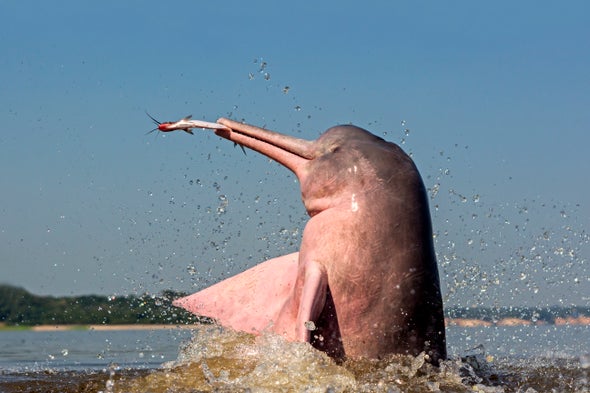(单词翻译:单击)
听力文本
This is Scientific American's 60-second Science, I'm Christopher Intagliata.
Freshwater dolphins live in many of the world's biggest rivers, from the Amazon to the Ganges, and they differ in many ways from their better-known oceangoing cousins. "They have a flexible neck. They have different types of teeth. They can also move their flippers independently in different directions, so they can swim backwards."
Gabriel Melo-Santos, a marine biologist at the University of St. Andrews in Scotland. "When I decided I was going to be a biologist I decided I wanted to study dolphins. And being born in the Amazon, it was only natural to go for the river dolphins."
He says another thing that sets his study subjects apart from marine dolphins are their calls (river dolphin calls).
Over several years, Melo-Santos has recorded the sounds of Araguaian river dolphins that came calling at the Mocajuba fish market, on Brazil's Tocantins River. Then using sound analysis software, his team fished 237 distinct sound types from the recordings—indicating the dolphins have a wide repertoire.

The call collection, published in the journal PeerJ, has only a few whistles. Instead, three quarters of the collected sounds were short two-parters, like this one (call) produced by a female calf as she rubbed her head on her mother's belly. It's a call that's more similar in structure to the ones orcas and pilot whales make to identify a family or social group than to the social whistles of marine dolphins.
"These are older lineages, right? So if you understand how these dolphins communicate, we might have a sense to understand how the communication system evolved in different lineages of cetaceans." Meaning perhaps these calls between mother and calf are, like the river dolphins themselves, an evolutionary relic.
Thanks for listening for Scientific American — 60-Second Science. I'm Christopher Intagliata.
参考译文
这里是科学美国人——60秒科学系列,我是克里斯托弗·因塔格里塔。
从亚马逊到恒河,全世界许多大型河流中都生活着淡水海豚,它们在很多方面都与人们所熟知的其远洋表亲存在不同。“它们的颈部非常灵活。它们的牙齿类型与众不同。它们还能独立地向不同方向移动鳍肢,这使它们可以向后游动。”
苏格兰圣安德鲁斯大学的海洋生物学家加布里埃尔·梅洛-桑托斯说到。“当我决定成为海洋生物学家时,我就决定研究海豚。因为我出生在亚马逊,所以选择河豚是很自然的事情。”
他说,他的研究对象与海豚的另一个区别是叫声(河豚的叫声)。
几年来,梅洛-桑托斯记录了巴西托坎廷斯河上莫卡朱巴鱼市上的阿拉瓜湾河豚的叫声。他的团队用声音分析软件捕获了237种不同类型的声音——这表明河豚拥有广泛的技能。
这个声音集发表在《PeerJ》期刊上,只有小部分声音是哨音。相反,有四分之三的声音是短促的、有两个参与者的声音,比如这种(叫声)这是一只雌性幼崽用头摩擦妈妈肚子时发出的声音。这种叫声在结构上更类似于虎鲸和领航鲸辨认家人或社会群体的声音,而不像海豚发出的社交哨声。
“这些是更古老的世系,对吧?因此,如果你了解这些海豚的交流方式,我们或许就能理解在鲸类动物的不同世系中,交流系统是如何进化的。”这意味着,也许河豚这种母子间交流的叫声,就像河豚本身一样,是进化的遗迹。
谢谢大家收听科学美国人——60秒科学。我是克里斯托弗·因塔利亚塔。
译文为可可英语翻译,未经授权请勿转载!
重点讲解
重点讲解:
1. be going to do sth. 想要(做…);决定(做…);
I'm going to be a good boy now.
我现在要做个乖孩子了。
2. go for 选择;挑选;
People tried to persuade him to go for a more gradual reform programme.
人们试图说服他采取更为渐进的改革方案。
3. set sb./sth. apart from 使与众不同;使突出;
What sets it apart from hundreds of similar small French towns is the huge factory.
与其他数百个法国小镇不同的是它拥有巨大的工厂。


